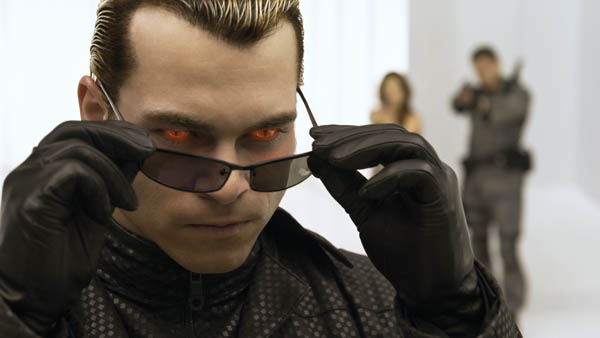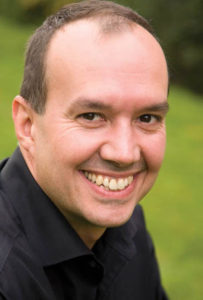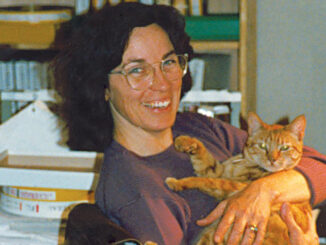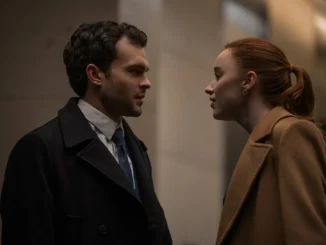
by Garrett Gilchrist • portrait by Gregory Schwartz
Director Paul W. S. Anderson made a name for himself helming high-octane action films, often based on popular video games, such as Mortal Kombat (1995) and Alien vs. Predator (2004). Having directed Resident Evil (2002) and written and produced two sequels, he has returned to direct Resident Evil: Afterlife, in full 3-D, which opens via Sony Screen Gems September 10. Taking on the difficult task of editing an effects-filled stereoscopic blockbuster-hopeful is fellow Brit Niven Howie, who has proven his chops as a clever and unique action editor with such films as Lock, Stock and Two Smoking Barrels (1998), Dawn of the Dead (2004); Death Race (2008) and Resident Evil: Extinction (2007). Howie also has a real passion for music, and worked with Julien Temple on documentaries about the Sex Pistols and the late Joe Strummer of the Clash. CineMontage caught up with Howie to discuss this challenging project.
CineMontage: How would you describe Resident Evil: Afterlife?
Niven Howie: It’s a classic rollercoaster ride of a movie. This is my third movie with Paul, and he’s extremely talented at creating very fun, pure entertainment. Each film has been a re-think. Hollywood always tries to copy the latest success, which is a big mistake. Modern audiences tire of the same thing very quickly. Paul is always looking to try new tricks and break new ground, and he’s excelled himself. The film looks amazing, especially in 3-D––very sleek and stylish, completely cinematic.
CM: Has the 3-D changed how you approach editing?
NH: We have some very fast-cut action sequences, but not quite as fast as I would have made them in 2-D. Paul went back to the rulebook and started again, in a more traditional style of filmmaking. A close-up is head and shoulders––never too close to camera, because the gap between the image on one eye and the other becomes so great that it hurts the viewer’s eyes. But you can flatten the image in post to make it less 3-D; separate the two images, or pull them together.

CM: Paul Anderson’s films tend to be very fast-cut.
NH: Everything has a natural rhythm, and there’s a limit to how fast you can cut between images. I’ve seen films where they shouldn’t have cut so quickly. But everything has its time and place. On Death Race, we broke the record for the number of edits in a movie: 3,000. Paul is a big fan of the “blipvert,” where you bombard the audience with extremely rapid images––an assault on the senses. But obviously that’s just for an effect. The dramatic scenes were quite slow and traditionally shot and cut.
CM: Is his style inspired by the video game of the same name, whose fans might be a younger audience?
NH: He cares about the fans, but his style is really what he likes. He plays the games himself, and felt that the video game Resident Evil would make an excellent movie. The films are quite different; they’ve created characters that don’t exist in the game, and Paul got some flak for that. But people love Milla’s character Alice; they identify with her. Milla Jovovich is incredible as ever. She’s matured into an extremely talented actress and brings an awful lot to these movies, this one in particular.
CM: How do you approach editing an action scene?
NH: Modern action movies tend to surround the action with cameras, and film a lot of angles that just get thrown out. Or they do the old John Woo trick and repeat the action several times from different angles. We have less coverage, since the 3-D camera rigs are not easily moved around. They’re very carefully boarded and choreographed, and shot for the cut––but covered very well.
They’re quite easy for me to tackle. Even so, Paul is quite happy to let me throw the storyboard away and get on with it. The storyboard isn’t necessarily reflective of what’s gone into the camera. I look through all the dailies, make notes and cut completely from my own instinctive gut feeling. Nine times out of ten, we’re pretty close to the locked scene. Paul might remember something from filming that he particularly liked, and we’ll put that in, but then it’s just the usual trimming and cutting of unnecessary lines. I cut out a lot of the dead wood as I’m going. It’s a waste of everyone’s time watching a four-hour assembly. Our first cut was two hours, which isn’t bad at all. Death Race was longer, but we had more to trim out. In a car race, you put in all your best, favorite shots, and then try to cut it down to size.
CM: And you can cut wherever you want in a car race; people generally don’t notice.
NH: Absolutely. I think we cut each one down to just long enough. Less is more. Beginning and ending a film is always the hardest. We lock every other reel first. Reel two always has all the talky exposition.
CM: You first worked with Anderson when he was writing and producing the third Resident Evil film, Extinction, directed by Russell Mulcahy in 2007.
NH: It had already been assembled––and pretty much everything was wrong with it. The rhythm was completely wrong. There were wide shots when they should be on close-ups, and vice versa. I said, “Give me three weeks and I’ll re-cut the first reel from scratch.” They loved what I’d done and I just continued on. It was a very enjoyable process.
If a film feels to me like it’s edited badly, it’s quite hard to put my finger on what was done wrong. It’s a domino effect. If one element’s wrong, everything tumbles down. The music doesn’t fit, the sound effects are fighting and it becomes a horrible mush. I let the actors’ eye movements guide my cuts. When an actor looks to someone else, I wait until they’ve looked, then cut to where they’re looking. It’s a simple thing, but when it’s not done right, it feels very weird. I pride myself on getting the best out of an actor. I want the final, polished movie to be something the actor will be pleased with. Paul and producer Jeremy Bolt rely on me for that. It’s about getting the best performance, choosing the best shots and making the overall pace and rhythm feel right.

CM: How did you start your career as an editor?
NH: I was a musician at college and kind of got sidetracked. I edited about 400 music videos over five years in London, starting in the late ‘80s. It was exciting; we were experimenting, breaking new ground. I moved into commercials, then television drama and short films. Eventually, one of my music video clients gave me that break and let me loose on a feature. That was Bullet, for Julien Temple in 1996, with Mickey Rourke and Tupac Shakur. I’m still very involved in the music that’s temped in and I work very closely with the composers. I feel it’s extremely important that music is married perfectly to the image.

CM: What was it like working with Guy Ritchie on Lock, Stock and Two Smoking Barrels…
NH: That was a fun experience. Two weeks into filming, someone recommended me, because their first editor didn’t really know how to use the edit system. It was this quirky, funny little low-budget British movie. We knew we had something special; the performances were so delicious, and the comedy was coming across so well. We removed the love story, which had been forced into the script and not shot particularly well. It had a very boring, obvious ending: the nice young guy gets the girl and the money. We completely changed the film into a total lad’s movie––which is what it was written as, and should have been from the start. The film was so much better for it.
I used techniques I’d used in music videos and commercials, and I was extremely nervous, thinking people would say it wasn’t cinematic. But those scenes tested so well that director Guy Ritchie shot more, made them longer. There’s a scene we affectionately call the drunk scene, where I ramped lots of shots––speeding up, slow-mo, cutting frames, jumping around in time and space, like a music video. I cut a lot of the scenes to music I was listening to at the time. I tried it, and people liked it, and the studio was happy to pay for the songs. Everyone did well with that film. It didn’t have much commercial impact in the States, but the industry saw it and took a lot of interest.
CM: You worked with Julien Temple again on the Sex Pistols documentary, The Filth and the Fury.
NH: On day one, Julien and I went to a storage center near Heathrow Airport where all these 25-year-old film cans were stored, to see what we could find. Our first cut was around four and a half hours. There was no script. We pieced together the drama found in these rusty old cans. It’s a very special film; I’m extremely proud of it. The Sex Pistols tapped into a whole movement of social unrest––a revolution, really––with disenfranchised youngsters finishing school who felt there really was no future. It was a rough time, but a very interesting time to be in London. Punk officially started in New York, but the Sex Pistols were the first band that anyone took note of; the Clash followed soon after.
CM: Speaking of the Clash, you were also one of the editors on Temple’s documentary Joe Strummer: The Future Is Unwritten.
NH: I knew Joe; he lived quite near Julien down in Somerset and we had socialized a lot. It was a bit of a passion project for all of us. Julien’s so thorough, and it was all really good stuff, which he’d collected over 25-30 years.
CM: Can you talk about Zach Snyder’s Dawn of the Dead?
NH: Zach is full of energy, really fun, very focused and knows exactly what he wants. An ideal director. I don’t know anyone who doesn’t get on with him. This was Zach’s first movie; he was a commercials director. Someone suggested me because I spoke that language. In our first conversation, he said he wanted the undead to be fast as hell. It was a risk, and a major decision to reboot the franchise. It was great fun.






